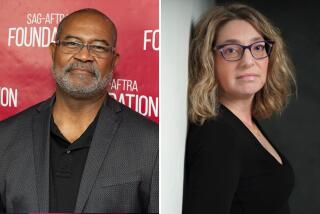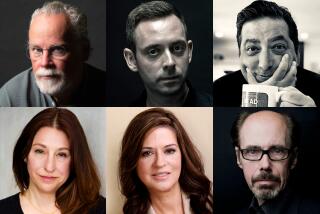Crime Fighters Make the Grade at Unusual New York College : Law: University trains police and civilians alike in varied aspects of the criminal justice system.
- Share via
NEW YORK — John Salamy, a 22-year-old aspiring FBI agent, was a bit disconcerted when he looked down during an exam and saw a .38-caliber revolver strapped to the ankle of the student next to him.
On this campus, you may smoke only in designated areas. You may carry your gun anywhere.
The John Jay College of Criminal Justice, part of the City University of New York, is indeed an unusual institution of higher learning.
It is a liberal arts college where you cannot major in English, history or philosophy, but you can major in forensic psychology, criminology or deviant behavior and social control.
A science lab is equipped to do DNA testing, the ultimate in identification. Kojak is now filming in the environs. A vintage firetruck, enclosed in glass, is the major artwork of one building.
“It’s the only school where you might have an ex-felon, a recovering alcoholic, an FBI man and a cop all taking notes in the same class,” said Dr. Charles Bahn, a psychology professor.
“In fact, we used to joke back when it was nearly all cops, ‘How do you grade a class where everybody is armed?’ We told them we gave credit for time served and were open to plea bargaining.”
John Jay is one of only a few colleges of criminal justice, including those at the universities of Chicago, Nebraska at Omaha, Wisconsin, Louisville, Baltimore and East Tennessee State.
Soon to celebrate its 25th anniversary, John Jay is still called the “cop school,” but it has expanded its horizons since it was housed in the Police Academy and all the students were New York’s finest.
In the ensuing years, the college moved to several different locations in Manhattan, but until the 1970s about 70% of its students were police officers.
Now housed in two buildings near Lincoln Center, and just south of a housing project, the student body is predominantly civilian, with only a quarter of them cops or others in uniformed services.
Still, the coffee shop-deli down the street would not make the day of an armed robber. There is a lot of firepower beyond those pastrami and corned beef sandwiches.
There are more than 8,000 students, most of them pursuing associate and bachelor’s degrees. In addition, 550 are working for their master’s and 103 their doctorate.
John Jay, named after the first U.S. chief justice, has a special mission within City University, the largest urban university in the country with 19 schools and 194,000 students.
Said Jay’s president, Gerald Lynch:
“We hope John Jay will help professionalize the criminal justice system, teach people in law enforcement that life is ambiguous, that life is made up of grays, that it will give them more compassion.
“We don’t teach fingerprinting here. We have a library, which I insisted be the first thing people see when they enter the new building. We have a 625-seat theater.
“The students learn things here they will use outside of their professional life, things to enrich their personal life.”
Students often complain about the liberal arts courses, since many have already decided on a career. Salamy, for example, wants to become either an FBI man or a Drug Enforcement Administration agent.
Despite the similarity of interest, there is great diversity.
“Students here want to be anything from probation officers to judges to senators,” said Julia Bryant, a school spokeswoman. “There are 19-year-olds who want to be on ’21 Jump Street’ and older cops who want to be (police) commissioner.”
There are also indications that some of the police students are preparing for a second career. Security management is an increasingly popular major.
“Maybe the biggest thrill of going to John Jay is knowing you are going to have a job when you get out,” said Dr. Lawrence Kobilinsky, who is a recognized DNA-fingerprinting expert.
Graduates are heavily recruited by would-be employers, including law enforcement agencies. The Rochester, N.Y., Police Department set up a recruitment table early this semester.
The school’s alumni include at least two dozen police chiefs across the country.
The Criminal Justice Center housed at Jay is sort of an advanced cop school, but students do not take formal courses. It offers workshops and seminars on such things as hostage negotiation, stakeout and surveillance techniques, confidential informants, clandestine drug labs, bomb awareness. The classroom is often the street.
These specials, usually given for law enforcement agencies but occasionally for private industry, are not open for public inspection. They do not want to give away secrets of the sleuthing trade.
The workshop was conducted by Lt. Frank Bunting, division chief of a drug enforcement task force that includes federal, state and city agents.
Bunting presented the latest technology and offered advice growing out of his own experience. In discussing surveillance he talked of “ghosts” and “uncles” and other undercover operatives.
The students role-play a drug bust, and sometimes they make mistakes. In one, the major suspect simply strolls out of the room, while the “arresting officers” question the lesser crooks.
Bunting poses another scenario:
“All right,” he said. “It’s 102 degrees out, you’re in the South Bronx and you’ve got 300 people around you now. What are you charging this guy with?”
A Latino cop, getting into the spirit, jumps up and confronts her classmate.
“What are you doing? That’s my brother. He didn’t do nothing.”
The laughter drowns out Bunting.
Bunting once gave a lecture to a group of mystery book writers and was deluged with offers to co-author a book.
Dr. Alan Goldstein, a psychology professor, said he was once teaching a class about schizophrenics and their usual nonviolent nature.
A cop-student asked: “Would you like me to show the class the two bullet holes I have in my buttocks from one of those nonviolent schizophrenics?”
Goldstein said that is one of the great strengths of John Jay.
“We all learn to be tolerant and we learn from each other.”
Meanwhile, back in the ivory tower part of the school, freshmen are wrestling with an English literature survey course, basic mathematics, speech, government 101, much as students at any college do. Half of their credits must be in traditional liberal arts courses, but even those have a criminal-justice flavor.
“Sometimes, we wish their interests were broader,” said Dr. Dorothy Bracey, head of the anthropology department and an expert on international policing, particularly the criminal justice system in China. “But, in another way, it makes it easier to teach here. In theory, all students have some interest in criminal justice.”
Forty percent of Jay’s students come from families that earn less than $12,000 a year. They are older than most college students and most of them work. About 80% receive some sort of financial aid.
The undergraduates are 36% black, 32% white, 28% Latino. Almost half are women.
Due to finances, about one-fourth graduate in four years. With work and aid, almost three-fourths stick out 10 to 14 semesters to graduate.
Still, about 500 students get their baccalaureates each year.
The staff includes Olga Ford, a retired New York City detective. She has worked as technical adviser for TV shows. There was a reported contract out on her when she helped bring down drug kingpin Nicky Barnes.
There is Dr. Ansley Hamid, an anthropology professor who specializes in crack-related violence and street gangs and maintains that crack is not as instantly addictive as it is being portrayed.
“The dealers are controlled users, or sometimes abstinent, and I recently met an 80-year-old grandmother, who has no previous history of alcohol or drug abuse, who is a controlled user,” Hamid said.
“Crack just came on us so fast, there was no time for a body of experiential users to teach others. Now people are coming up with strategies for recreational use of crack. They might mix a little with some marijuana, for instance.”
Is this a rather benign view of crack?
“Not benign,” Hamid said, “just a business-as-usual view of underground economies.
“The real danger is the destruction of families and crack does the footwork. The marijuana dealer lasted a long time. Eventually he bought a small bakery or maybe a boutique in the neighborhood. With crack, the money doesn’t stay here.
“The crack dealer doesn’t last long. He is either arrested, killed by the competition or he becomes a crack-head himself. But when he has the money, he conspicuously consumes, buying fancy imported cars and jewelry. The money doesn’t go back into the community that generated it.”
Over at the Criminal Justice Center, there is William McCarthy, retired New York City detective. With the code name “Mother,” he was once the undercover owner of two houses of prostitution. As head of the bomb squad when he retired, he was known as “Billy Bombs.”
Now working on his doctorate, McCarthy said: “If it weren’t for John Jay, I would never have gotten my bachelor’s and master’s degrees. Back then, it was the only place a cop could go.”
In the next office sits William Louden, also working on his doctorate. Louden was the NYPD’s chief hostage negotiator.
Psychology professor Bahn likes to tell about the FBI man in a public service administration course. The professor lectured that changes in top leadership should occur at least every 10 years. Loyal to long-tenured J. Edgar Hoover, the FBI man challenged that. So the professor assigned him to write a paper justifying his point of view.
Working at his office, the FBI man did some research on the pros and cons of Hoover’s long stewardship, pitching the carbons into the waste basket where another agent found them. The FBI-author agent was greeted the next morning by two FBI agents who announced that he was under investigation.
He explained to the department that this was not a plot. It was homework.
An angry Hoover was on the telephone immediately to John Jay: “What are you going to do about that professor who is trying to undermine me?”
“I’ll tell him you called,” was the reply of a school that will not suffer intimidation.
More to Read
Sign up for Essential California
The most important California stories and recommendations in your inbox every morning.
You may occasionally receive promotional content from the Los Angeles Times.









